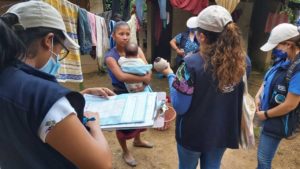Nutrition brigades in Guatemala screen for malnutrition in remote communities
OCHA and humanitarian partners have used the opportunity of a mission to the Guatemalan department of Huehuetenango in late August to see first-hand the work being done by “nutritional brigades” and joined them in their calls to assist households impacted by food insecurity and malnutrition….
OCHA and humanitarian partners have used the opportunity of a mission to the Guatemalan department of Huehuetenango in late August to see first-hand the work being done by “nutritional brigades” and joined them in their calls to assist households impacted by food insecurity and malnutrition.
In recent years, levels of food insecurity and acute malnutrition in Guatemala have increased not only across the drought-hit region called the “Dry Corridor”, but also in other departments with high rates of poverty and underdevelopment. Fifty-nine per cent of the population is currently in poverty (10 million), a figure that increases to 77 per cent in areas with indigenous populations. Half of all children in Guatemala aged under 5 years suffer from chronic malnutrition.
The department of Huehuetenango, in the highlands of western Guatemala, has been targeted for the disbursement of an allocation from the UN Central Emergency Relief Fund (CERF) , which has allowed for specific interventions including in the sectors of food assistance, nutrition, health, agriculture, gender-based violence, protection for women and girls, and water, sanitation and hygiene.
The COVID-19 pandemic has increased food insecurity. According to the Humanitarian Needs Overview published in March 2020, before the start of the pandemic some 2.3 million people were food insecure in Guatemala. Estimates from the Food Security Cluster indicate that food insecurity now affects some 461,000 families – about 2.8 million people – due to loss of livelihoods, impact on remittance income, informal work affected by restrictions, increase in food prices, and decline in agricultural and non-agricultural exports. Particularly worrying is the increase in acute malnutrition in children under 5. Although not all of the data are available, it is estimated that the rebound could be between 40 and 50 per cent over 2019.
The nutrition brigades, which were created by the Nutrition Cluster in Guatemala under the leadership of the UN Children’s Fund (UNICEF) and Action Against Hunger, visit targeted communities and make house-to-house calls, mostly in remote areas, in order to screen children aged under 5 years. They typically include a nurse, a nutritionist and a social worker, with staff from the Ministry of Health and UN agencies.
Going from one community to another, the brigades apply a sequence of actions, starting with child registration, where they check public health cards for data about the child as well as the mother. They also take anthropometric measurements, including the mid-upper arm circumference of the child to define if he or she suffers from acute malnutrition or is at risk of malnutrition.
The brigades also take height and weight measurements, if necessary, as well as analyse clinical signs of malnutrition and provide nutritional counselling on breastfeeding and healthy diet.
The strategy designed by the Nutrition Cluster to fight acute malnutrition in Guatemala has been endorsed and adopted by the Ministry of Health and the National Food Security and Nutrition System, for which the Cluster is currently developing guidelines and manuals for the creation and training of the brigades. Some 45 additional brigades are now operating in other departments outside CERF coverage, with the support of Oxfam, Action Against Hunger and WFP.
